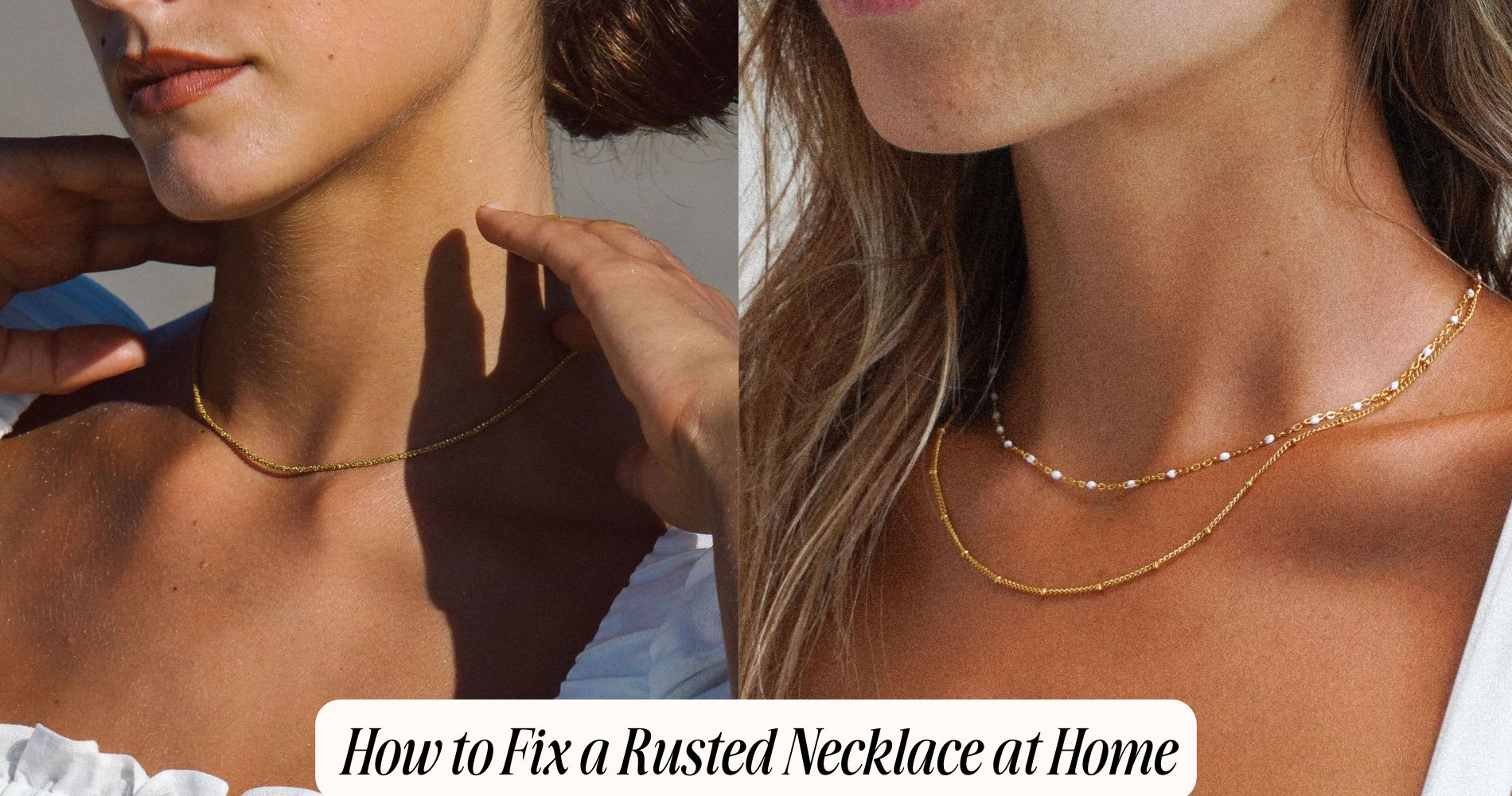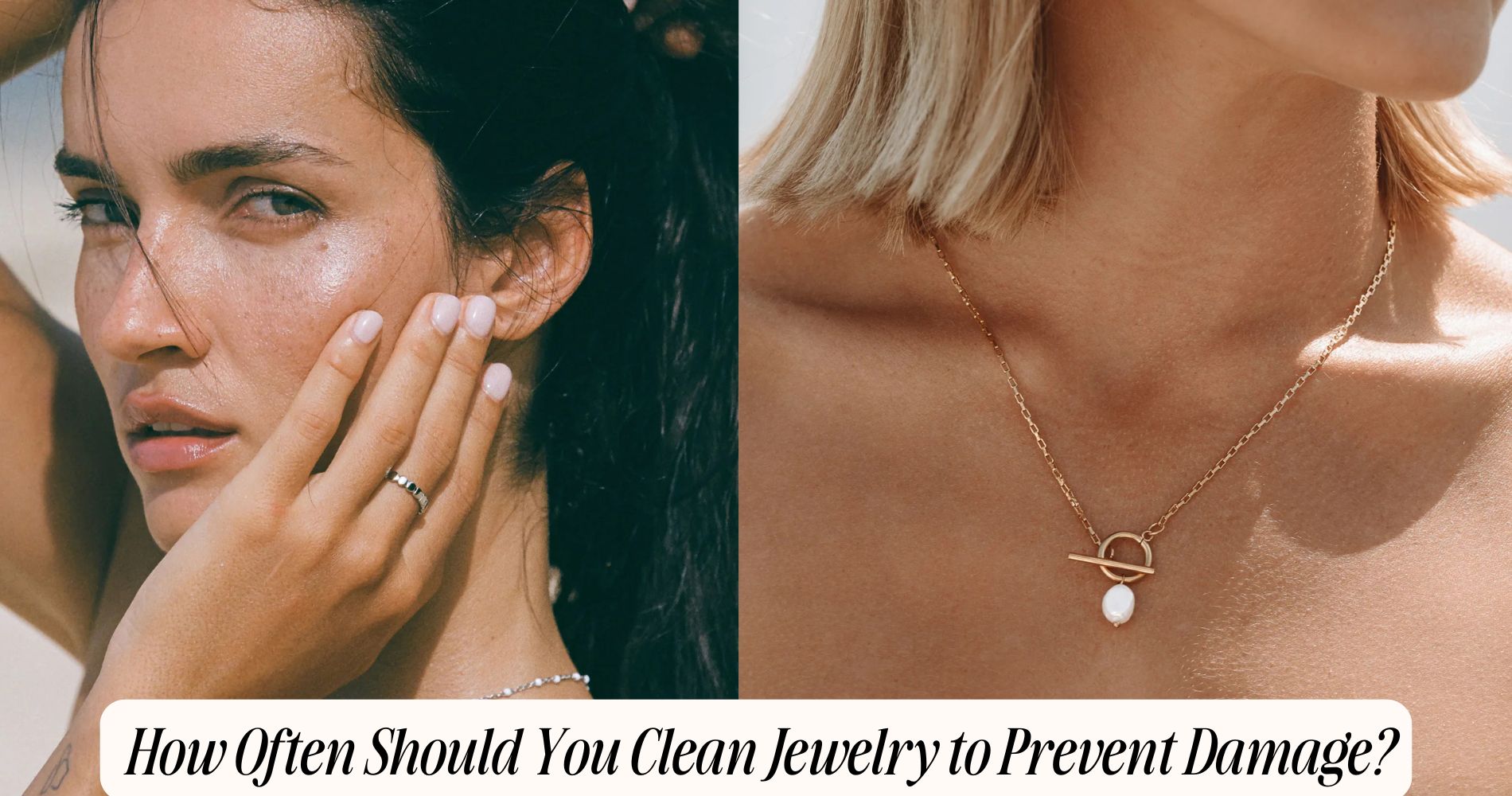
How to Fix a Rusted Necklace at Home
Dealing with a rusted necklace can be frustrating, but with the right approach, you can restore its original shine. Learning how to fix a rusted necklace starts with evaluating the damage and identifying the type of rust. Next, gather essentials like warm soapy water, a soft-bristled toothbrush, and rust removal products. Simple solutions like soaking the necklace in white vinegar or using a baking soda paste can effectively remove rust. After cleaning, rinse thoroughly, dry with a microfiber cloth, and consider adding a protective sealant. To avoid rust in the future, store your necklace in a cool, dry place—or opt for durable options like our waterproof necklaces collection for long-lasting beauty and care.
Assessing the Damage
Before you begin cleaning your rusted necklace, it's essential to assess the damage thoroughly. Start by identifying the rust types present on your necklace. Common types include surface rust, which appears as a flaky, reddish-brown coating, and deep rust, which can create pitting or structural weakness in the metal.
Next, examine the necklace materials. Different materials respond uniquely to rust. For example, stainless steel might only require a light scrubbing, while a copper necklace could need a more specialized approach due to oxidation.
Carefully inspect any clasps, chains, or embellishments, ensuring that no part is compromised. Consider the extent of the rust. If it's only superficial, you're likely in good shape. However, if you notice significant corrosion or wear, you may need to rethink your cleaning strategy or even consider professional restoration.
Document any specific areas of concern, noting the rust type and material composition, so you're prepared for the next steps. This assessment won't only guide your cleaning approach but also help prevent further damage during the restoration process.
Cleaning Supplies Needed
Gathering the right cleaning supplies is vital for effectively restoring your rusted necklace. Start with a gentle cleaning solution, such as a mixture of warm water and mild dish soap. This will help break down any surface grime without causing further damage to your jewelry.
You'll also need a soft-bristled toothbrush or a cotton swab to reach intricate details without scratching the metal.
Next, consider rust inhibitors. These are important for preventing future corrosion. Look for rust-inhibiting sprays or solutions specifically designed for jewelry, as they can provide a protective barrier after cleaning.
You might also want to acquire a microfiber cloth for drying and polishing the necklace after the cleaning process.
If your necklace has beads or gemstones, make certain you use a suitable cleaner that won't affect their appearance. Acetone or bleach can be harmful, so avoid those.
Having these supplies on hand will streamline your cleaning process and make sure you're well-prepared. This proactive approach allows you to restore your necklace to its former glory while safeguarding it against future rusting.
Always remember, the right supplies are the foundation for effective cleaning.
DIY Rust Removal Techniques
With the right cleaning supplies ready, you can start tackling the rust on your necklace using various DIY techniques. One effective method is the vinegar soak.
Begin by submerging your rusted necklace in a bowl of white vinegar for about 30 minutes. The acetic acid in the vinegar will help dissolve the rust. After soaking, gently scrub the necklace with a soft brush or cloth to remove any remaining rust particles. Rinse thoroughly with water and dry completely.
Another technique involves baking soda. Create a paste by mixing two parts baking soda with one part water. Apply this paste directly onto the rusted areas of the necklace. Allow it to sit for 15 to 20 minutes, then scrub with a soft brush or cloth.
Baking soda's mild abrasiveness will help lift the rust without damaging the jewelry. Rinse the necklace under warm water and dry it with a soft cloth.
Both methods are effective and environmentally friendly. Choose the method that best suits your needs, and you'll have your necklace looking like new in no time.
Preventive Measures for Future
To keep your necklace looking pristine and prevent rust from accumulating in the future, it's crucial to adopt a few key maintenance practices.
First, guarantee proper rust prevention by keeping your necklace dry. Avoid wearing it in humid environments or while swimming, as moisture accelerates rust formation.
Next, focus on jewelry storage. Invest in a soft-lined jewelry box or a specialized organizer with compartments to minimize contact with other pieces. If possible, store your necklace in an anti-tarnish pouch or cloth to further protect it from oxidation.
Regularly inspect your necklace for any signs of wear or rust. If you notice any issues, address them immediately to prevent escalation.
Additionally, consider applying a thin layer of protective wax or sealant specifically designed for jewelry to create a barrier against moisture and air.
Finally, clean your necklace regularly using a soft, lint-free cloth to remove dirt and oils that can contribute to rust.
Final Touches and Care
After taking the necessary preventive measures, focusing on the final touches and care of your rusted necklace is vital to restoring its original shine.
Begin with polishing techniques that suit the material of your necklace. For metal jewelry, use a soft microfiber cloth and a metal polish designed for your specific metal type. Apply a small amount of polish, buffing gently in circular motions to remove tarnish and restore luster. If your necklace has stones, make sure you avoid getting polish on them, as it can damage their finish.
Once polished, rinse the necklace under lukewarm water to eliminate any residue, then dry it thoroughly with a clean cloth. To maintain its shine, consider using a jewelry cleaning solution periodically, following the manufacturer's instructions.
After cleaning, proper storage solutions are imperative. Store your necklace in a dry, cool place, ideally in a fabric-lined jewelry box or a pouch. Avoid hanging it up, as this can lead to tangling or scratching.
Additionally, consider using anti-tarnish strips in your storage area to minimize future rusting. With these final touches and care, your necklace will remain beautiful and rust-free for years to come.
Frequently Asked Questions
Can I Use Vinegar on All Types of Jewelry?
You can't use vinegar on all jewelry types; it may damage pearls, opals, and certain metals. Consider vinegar alternatives like baking soda or mild soap for delicate items, ensuring you protect your jewelry's integrity.
How Long Should I Soak the Necklace in Cleaning Solution?
You should soak the necklace in the cleaning solution for about 15 to 30 minutes. This soaking duration allows the solution to effectively break down rust without damaging the jewelry's material. Rinse thoroughly afterward.
What if the Rust Persists After Cleaning?
If the rust persists after cleaning, try additional rust removal techniques like using a soft brush or a vinegar solution. Follow jewelry restoration tips to prevent future rust, ensuring your pieces stay beautiful and intact.
Is It Safe to Use Baking Soda on My Necklace?
Yes, it's safe to use baking soda on your necklace. Its effectiveness in removing rust makes it a suitable option. Just guarantee you test a small area first to confirm your necklace's safety and integrity.
Can I Prevent Rusting by Storing My Necklace in a Certain Way?
You can prevent rusting by employing preventive measures like storing your necklace in airtight containers or using anti-tarnish pouches. These storage solutions minimize exposure to moisture, markedly reducing the likelihood of rust formation.
Conclusion
Now that you've assessed the damage and successfully cleaned your rusted necklace, it's time to implement preventive measures to protect it from future rust. Regularly clean and store your jewelry in a dry, airtight container to minimize exposure to moisture. By following these steps and maintaining proper care, your necklace will not only look great but also last longer. Enjoy wearing your revitalized piece with confidence, knowing you've restored it to its former glory.
























Leave a comment
This site is protected by hCaptcha and the hCaptcha Privacy Policy and Terms of Service apply.